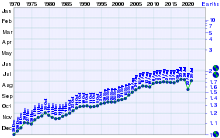地球超載日
地球超載日(英語:Earth Overshoot Day,EOD ),又稱作生態負債日(英語:Ecological Debt Day,EDD),是一個計算出的日期,它表示在這一天,人類的資源消耗超過了地球本年度再生這些資源的能力。「超載」表示人類人口的需求超過地球上再生生物資源的可持續水平。從經濟角度看,每年的地球超載日表示地球的本年度再生預算在這天耗盡,人類進入環境赤字支出。 地球超載日的計算方法是世界生物承載力(本年度地球產生的自然資源量)除以世界生態足跡(當年人類對地球自然資源的消費),再乘以365(閏年為366),即一年中的天數:

2020年,由於冠狀病毒在全球範圍內引發大規模封鎖,計算出的超載日落在8月22日(比2019年晚了三周多)。[2]全球足跡網絡主席稱, COVID-19大流行本身就是「生態失衡」的表現之一。[3]
地球超載日由全球足跡網絡計算,是一項得到數十家其他非營利組織支持的活動。[4]有關全球足跡網絡的計算[5]和國家生態足跡的信息可在線獲取。[6]
背景
編輯| 年 | 地球超載日 | 年 | 地球超載日 | |
|---|---|---|---|---|
| 2017年 | 8月2日 | 2021年 | 7月29日 | |
| 2018年 | 8月1日 | 2022年 | 7月28日 | |
| 2019年 | 7月29日 | 2023年 | 8月2日 | |
| 2020年 | 8月22日 | 2024年 | 8月1日 |
英國智庫新經濟基金會的安德魯·西姆斯最早提出了地球超載日的概念。全球足跡網絡是新經濟基金會的合作夥伴組織,每年都會發起地球超載日活動,以提高人們對地球資源限度的認識。全球足跡網絡衡量人類對自然資源和生態服務的需求和供應。他們估計,2022年,在不到七個月的時間裡,人類對大自然的需求就超過了地球生態系統全年的再生能力。[4]人類需求包括所有競爭地球表面再生能力的需求,例如可再生資源、 CO2封存和城市空間。
根據全球足跡網絡的研究,在人類歷史的大部分時間裡,人類利用自然資源建造城市和道路、提供食物、製造產品、排放二氧化碳的速度完全在地球預算範圍內。但到了20世紀70年代初,臨界點已經突破:人類的消耗量開始超過地球的再生能力。按照他們的說法,目前人類對資源的需求量相當於1.7個地球以上。[7]數據顯示,我們可能在21世紀中葉之前就需要相當於兩個地球的資源。他們指出,資源枯竭的代價正變得越來越明顯。氣候變化(由溫室氣體排放導致)的後果最為明顯,影響最為廣泛。其他生物物理影響包括:森林砍伐、物種喪失、水土流失或漁業崩潰。這種資源不安全會導致經濟壓力(如貨幣通脹)和衝突(如內亂)。[4]
全球足跡網絡認為,生態足跡賬戶記錄了人類需求與再生能力之間的差距。他們說,現在的需求已經超過了地球的再生能力。他們承認核算方法有改進空間,還可增加更多細節,認為目前應用在各國的計算方法通常低估了人類需求,因為並非所有方面都得到了衡量(聯合國數據存在差距)。他們還聲稱高估了生物承載力,因為很難確定當前的再生量中有多少是以未來量的減少為代價的(例如過度使用地下水或水土流失的情況)。[8]全球足跡網絡的創始人兼總裁Mathis Wackernagel表示,農田的土壤退化可以包含在計算地球超載日的生態足跡賬戶中,但這「需要聯合國數據集中不存在的數據集」。[9]因此,他們稱,生態足跡賬戶是僅定義可持續性最低條件的指標,並且人類對地球的影響可能高於他們的賬戶所揭示的結果。
參考文獻
編輯- ^ Past Earth Overshoot Days - #MoveTheDate of Earth Overshoot Day.
- ^ Earth Overshoot Day June Press Release. overshootday.org. Global Footprint Network. [2020-08-10]. (原始內容存檔於2023-07-05).
- ^ Braun, Stuart. Coronavirus Pandemic Delays 2020 Earth Overshoot Day by Three Weeks, But It's Not Sustainable. Deutsche Welle. Ecowatch. 21 August 2020 [23 August 2020]. (原始內容存檔於2023-03-23).
- ^ 4.0 4.1 4.2 About Earth Overshoot Day. overshootday.org. Global Footprint Network. [July 15, 2018]. (原始內容存檔於2020-06-04).
- ^ Ecological Footprint: data and accounting methodology. footprintnetwork.org. Global Footprint Network. [2023-05-19]. (原始內容存檔於2019-11-08).
- ^ Biocapacity and Ecological Footprint: open data platform. footprintnetwork.org. Global Footprint Network. [2023-05-19]. (原始內容存檔於2017-08-08).
- ^ Footprint Open Data Platform, https://data.footprintnetwork.org (頁面存檔備份,存於網際網路檔案館), Global Footprint Network, York University & Fodafo.
- ^ Wackernagel, Mathis; et al. Handbook of Sustainability Indicators – Chapter 16 – Ecological Footprint: Principles & Chapter 33 – Ecological Footprint: Criticisms and applications. Routledge.
- ^ Pearce, Fred. Admit it: we can't measure our ecological footprint. New Scientist. [2 August 2017]. (原始內容存檔於2017-08-02).
延伸閱讀
編輯- Catton, William R. Jr. (1980). "Overshoot: The Ecological Basis of Revolutionary Change". Urbana: University of Illinois Press. ISBN 0-252-00818-9ISBN 0-252-00818-9.
- Easterling, William E. Climate change and the adequacy of food and timber in the 21st century. Proceedings of the National Academy of Sciences. 2007, 104 (50): 19679. PMC 2148356 . PMID 18077399. doi:10.1073/pnas.0710388104 .
- Khanna, Parag. The Second World . New York: Random House. 2008. ISBN 978-81-7036-406-1.
- WWF: human consumption is outpacing earth's capacity. EurActiv.com. October 26, 2004 [2023-05-19]. (原始內容存檔於2023-05-19).
- Wackernagel, Mathis; Schulz, Niels B.; Deumling, Diana; Linares, Alejandro C.; Jenkins, Martin; Kapos, Valerie; Monfreda, Chad; Loh, Jonathan; Myers, Norman; Norgaard, Richard; Randers, Jorgen. Tracking the ecological overshoot of the human economy. Proceedings of the National Academy of Sciences. 2002, 99 (14): 9266–9271. Bibcode:2002PNAS...99.9266W. PMC 123129 . PMID 12089326. doi:10.1073/pnas.142033699 .
- Damassa, Tom. Human Consumption Pushing Ecosystems to the Brink. EarthTrends Environmental Information. October 26, 2006. (原始內容存檔於2006-11-09).
- Futehally, Ilmas. Living Beyond Our Means. Strategic Foresight Group. [2023-05-19]. (原始內容存檔於2023-05-19).
